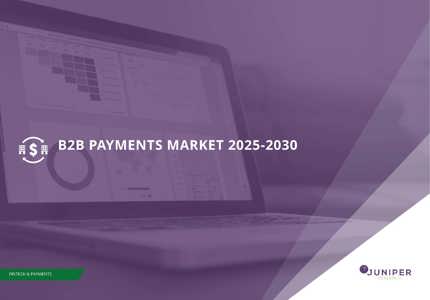What Channels Are Key to B2B Payments' Success?
The vast array of different payment methods available to businesses of all sizes today and increasing digitisation and digital channels mean that reconciling all payments across a variety of channels that work differently is proving to be highly challenging.
As we discuss in our latest free whitepaper, automation promises to reduce the manual labour and time cost associated with reconciling B2B payments, for instance, by facilitating automatic invoice matching, aggregating data and comprehensive analytics, and managing supplier relations.
However, before the benefits of automation can be understood, it is first helpful to understand the channels that B2B payments can take, both in domestic and cross-border markets.
Instant Payments Schemes
Instant payments schemes are instrumental in leveraging domestic payment rails and other associated technological infrastructures, such as international schemes, (ie, pan-regional clearing systems) to achieve higher-speed and lower-cost payments.
Most of these schemes are currently domestic (ie. Faster Payments in the UK, FAST in Singapore), but there are also initiatives such as SEPA Inst (Single Euro Payments Area Instant Payments) that are designed to cater for cross-border payments.
Moreover, increased efforts to bilaterally connect domestic instant payments schemes to facilitate cross-border payments and remittances (ie, in Southeast Asia) are taking shape at present, mostly due to the need to seek better ways of trading, amplified by the pandemic’s impact. Such moves can also alleviate the uneven adoption of instant payments schemes in the context of cross-border trades and potentially lead to their improvement for B2B payments.
Cheques and Electronic Cheques
Although paper cheques may seem to belong to a bygone era, they still constitute a considerable proportion of B2B payment methods globally. Settlement of cheques are often lengthy and costly, more importantly, this method is prone to human error and fraud.
Cheques in B2B payments are still prevalent, with the US and parts of Europe being resistant to move to digitisation. In part, traditional cheques are also being replaced by eCheques for greater efficiency in processing and ease in recurrent payments.
In eCheque scenarios, a transferor’s bank account information and the cheque amount are electronically transmitted to the relevant clearing institution (ie, ACH [Automated Clearing House] in the US) to initiate the withdrawal. While they are gaining ground, eCheques are yet to challenge traditional cheques’ dominance in B2B payments.
Cards and Virtual Cards
Corporate card offerings in B2B payments are widespread with payment network-branded cards (ie, Visa, Mastercard, American Express) leading these offers in the market. Corporate cards are usually utilised for organisational expenses, such as travel, and often viewed as instruments to manage internal purchases, as opposed to making high-value payments.
This perception is slowly changing with rewards, linked business accounts and virtual cards, which provide more secure transactions, presented by card providers. However, transaction costs and overall card acceptance rates of transacting parties impede their growth. Processing fees associated with B2B credit cards are typically in the range of 3%-5%, with the potential for this figure to be higher when used for cross‑border payments.
Another important element hindering greater card adoption is fraud, largely mitigated by the introduction of virtual cards, which randomise card details for each transaction. Moreover, these cards can hold embedded features such as spend limits, restrictions on where they can be used and rewards/points per spend.
Nevertheless, as a newer form of payment, virtual cards come as linked to existing corporate card offers and often require platform acceptance from the fund receiver which might not be readily available. While they can be an alternative to physical cards in terms of security, virtual cards will need to simplify and bolster their offerings for wider customer uptake.
Traditional Payment Schemes/Bank Payments
Electronic payments via banks or A2A transfer between corporate accounts are commonplace for B2B payments and have had some success in replacing the use of cash and paper cheques.
Corporate payments through banks can also utilise instant payments schemes (ie, Faster Payments in the UK for domestic B2B payments, SEPA Inst in most European countries for cross-border ones) or the clearing institutions (ie, ACH in the US) dependent on the characteristics of the market, availability, and maturity of the payment rails and alternatives.
Roadblocks in wider acceptance and usage of bank payments include processing speed and delays, high processing costs, and the interlinked organisational-level challenge of automating and scaling such payments where needed, to reduce associated labour and system costs. Transforming AP (Accounts Payable) and AR (Accounts Receivable) systems from legacy to cloud‑based ones for automation can deter organisations, not only because of budgetary constraints, but sometimes also due to compliance concerns.
Blockchain Payment Networks
The surge in blockchain payment networks in recent years to handle B2B payments processing had caused major actors in the market (ie, Visa, IBM, Mastercard, Ripple) to carve out niche B2B payments services and solutions based on blockchain. Similarly, smaller and specialised fintechs are rapidly developing their offerings.
Blockchain payment networks usually involve the use of a stablecoin, namely, a digital currency linked to single fiat currency or a basket of fiat currencies to ensure its stability and suitability as a payment/transfer method.
Alternatively, vendors can provide Open APIs (Application Programming Interfaces) for customers to build their own solutions on top of blockchain networks (ie, Visa B2B Connect solution). CBDCs’ (Central Bank Digital Currencies) growing popularity worldwide will also add to proliferation of use cases in blockchain for B2B payments in the near future.
Related Reading
Our complimentary whitepaper, How Automation Is Unlocking the B2B Payments Market, examines the state of this traditionally challenging market, and how automation, among other technological approaches, is improving processes.
"The global transaction value of the B2B payments market will exceed $111 trillion in 2027, from just over $88 trillion in 2022. It predicts this growth of 26% will be driven by rising prices caused by rampant inflation, as well as by strong economic growth in developing markets. The report identified the increased automation of accounts payable and receivable as being critical to the growing efficiency of payments processing; creating a significant opportunity for B2B payment vendors."
Latest research, whitepapers & press releases
-
 ReportDecember 2025
ReportDecember 2025AI Agents for Customer Experience Platforms Market: 2025-2030
Our comprehensive AI Agents for Customer Experience Platforms research suite comprises detailed assessment of a market that is set to disrupt mobile communications. It provides stakeholders with insight into the key opportunities within the AI agents for customer experience platforms market over the next two years.
VIEW -
 ReportDecember 2025Fintech & Payments
ReportDecember 2025Fintech & PaymentseCommerce Fraud Prevention Market: 2025-2030
Our eCommerce Fraud Prevention research suite provides a detailed and insightful analysis of this evolving market; enabling stakeholders from financial institutions, law enforcement agencies, regulatory bodies and technology vendors to understand future growth, key trends, and the competitive environment.
VIEW -
 ReportNovember 2025Telecoms & Connectivity
ReportNovember 2025Telecoms & ConnectivityeSIMs & iSIMs Market: 2025-2030
Juniper Research’s eSIMs and iSIMs research suite offers insightful analysis of a market set to experience significant growth in the next five years. The research suite provides mobile network operators (MNOs), original equipment manufacturers (OEMs), and eSIM management and platforms vendors with intelligence on how to capitalise on the market growth, and guidance on how eSIM-only devices and sensors, SGP.42, in-factory provisioning, and iSIMs will change the competitive landscape.
VIEW -
 ReportNovember 2025Fintech & Payments
ReportNovember 2025Fintech & PaymentsModern Card Issuing Platforms Market: 2025-2030
Our Modern Card Issuing Platforms Market research suite provides a detailed and insightful analysis of this evolving market; enabling stakeholders from banks, financial institutions, fintech companies, and technology vendors to understand future growth, key trends, and the competitive environment.
VIEW -
 ReportNovember 2025Fintech & Payments
ReportNovember 2025Fintech & PaymentsDigital Wallets Market: 2025-2030
Our digital wallets research suite provides detailed analysis of this rapidly changing market; allowing digital wallet providers to gain an understanding of key payment trends and challenges, potential growth opportunities, and the competitive environment.
VIEW -
 ReportOctober 2025Fintech & Payments
ReportOctober 2025Fintech & PaymentsDigital Identity Market: 2025-2030
Juniper Research’s Digital Identity research suite provides a comprehensive and insightful analysis of this market; enabling stakeholders, including digital identity platform providers, digital identity verification providers, government agencies, banks, and many others, to understand future growth, key trends, and the competitive environment.
VIEW
-
 WhitepaperDecember 2025Telecoms & Connectivity
WhitepaperDecember 2025Telecoms & ConnectivityHuman + AI: Drivers of Customer Experience AI Agents in 2026
Our complimentary whitepaper, Human + AI: Drivers of Customer Experience AI Agents in 2026, examines the key drivers of the AI agents for customer experience platforms market in 2025.
VIEW -
 WhitepaperDecember 2025Fintech & Payments
WhitepaperDecember 2025Fintech & PaymentsBeyond Chargebacks: The True Cost of Fraud for Digital Commerce
Our complimentary whitepaper, Beyond Chargebacks: The True Cost of Fraud for Digital Commerce, examines the state of the eCommerce fraud prevention market; considering the impact of evolving digital fraud strategies, including key trends such as identity theft, account takeovers, chargebacks, policy abuse and friendly fraud.
VIEW -
 WhitepaperNovember 2025Telecoms & Connectivity
WhitepaperNovember 2025Telecoms & ConnectivityeSIM-only Devices: The Impact on Operators, Consumers, and IoT
Our complimentary whitepaper, eSIM-only Devices: The Impact on Operators, Consumers, and IoT, explores the challenges and opportunities for the three segments, with a particular focus on eSIM-only smartphones and SGP.42.
VIEW -
 WhitepaperNovember 2025Fintech & Payments
WhitepaperNovember 2025Fintech & PaymentsUnlocking the Next Stage of Growth for Modern Card Issuing Platforms
This free whitepaper analyses key trends shaping the modern card issuing space, and the ways in which modern card issuing platforms can capture growth.
VIEW -
 WhitepaperNovember 2025Fintech & Payments
WhitepaperNovember 2025Fintech & PaymentsTop 10 Fintech & Payments Trends 2026
Fintech is evolving fast. From stablecoins to agentic AI, our annual guide reveals the shifts redefining payments, digital identity, and the future of money in 2026. Download your copy today.
VIEW -
 WhitepaperNovember 2025Fintech & Payments
WhitepaperNovember 2025Fintech & PaymentsDigital Wallets: Empowering Financial Inclusivity
Our complimentary whitepaper, Digital Wallets: Empowering Financial Inclusivity, examines the state of the digital wallets market; considering the impact of digital wallets on different geographies, how they are shaping the modern payments landscape through lower transaction fees and promoting financial inclusivity for underbanked populations, and how they are competing with established payment methods.
VIEW
-
IoT & Emerging Technology
Juniper Research Unveils Top 10 Emerging Tech Trends to Watch in 2026
January 2026 -
Fintech & Payments
Digital Identity App Usage to Hit 6.2 Billion by 2030, Driven by Shift to Decentralised Models
December 2025 -
Telecoms & Connectivity
Travel eSIM Margins Under Pressure as Revenue per Gigabyte Falls 10% Globally in Two Years
December 2025 -
Telecoms & Connectivity
AI Agents to Power 1,000% More Customer Interactions for Enterprises Globally by 2027
December 2025 -
IoT & Emerging Technology
Global D2C Revenue Set for $370 Million Surge, But Satellite Operators Should Not Chase Full MNO Status
December 2025 -
Fintech & Payments
Digital Goods Fraud to Cost eCommerce Merchants $27 Billion Globally by 2030 as AI Tools Accelerate Attacks
December 2025





















